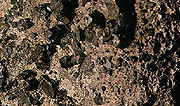
Zoisite, first known as saualpite, after its type locality, is a calcium aluminum hydroxy sorosilicate belonging to the epidote group of minerals. Its chemical formula is Ca2Al3(SiO4)(Si2O7)O(OH).
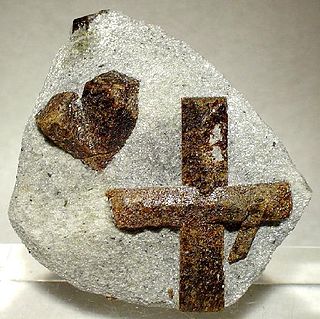
Staurolite is a reddish brown to black, mostly opaque, nesosilicate mineral with a white streak. It crystallizes in the monoclinic crystal system, has a Mohs hardness of 7 to 7.5 and the chemical formula: Fe2+2Al9O6(SiO4)4(O,OH)2. Magnesium, zinc and manganese substitute in the iron site and trivalent iron can substitute for aluminium.

Proustite is a sulfosalt mineral consisting of silver sulfarsenide, Ag3AsS3, known also as ruby blende, light red silver, arsenic-silver blende or ruby silver ore, and an important source of the metal. It is closely allied to the corresponding sulfantimonide, pyrargyrite, from which it was distinguished by the chemical analyses of Joseph L. Proust (1754–1826) in 1804, after whom the mineral received its name.

Alunite is a hydroxylated aluminium potassium sulfate mineral, formula KAl3(SO4)2(OH)6. It was first observed in the 15th century at Tolfa, near Rome, where it was mined for the manufacture of alum. First called aluminilite by J.C. Delamétherie in 1797, this name was contracted by François Beudant three decades later to alunite.

Adamite is a zinc arsenate hydroxide mineral, Zn2AsO4OH. It is a mineral that typically occurs in the oxidized or weathered zone above zinc ore occurrences. Pure adamite is colorless, but usually it possess yellow color due to Fe compounds admixture. Tints of green also occur and are connected with copper substitutions in the mineral structure. Olivenite is a copper arsenate that is isostructural with adamite and there is considerable substitution between zinc and copper resulting in an intermediate called cuproadamite. Zincolivenite is a recently discovered mineral being an intermediate mineral with formula CuZn(AsO4)(OH). Manganese, cobalt, and nickel also substitute in the structure. An analogous zinc phosphate, tarbuttite, is known.

Cobaltite is a sulfide mineral composed of cobalt, arsenic, and sulfur, CoAsS. It naturally appears in the form of a tetartoid, a form of dodecahedron with chiral tetrahedral symmetry. Its impurities may contain up to 10% iron and variable amounts of nickel. Structurally, it resembles pyrite (FeS2) with one of the sulfur atoms replaced by an arsenic atom.

Tetrahedrite is a copper antimony sulfosalt mineral with formula: (Cu,Fe)
12Sb
4S
13. It is the antimony endmember of the continuous solid solution series with arsenic-bearing tennantite. Pure endmembers of the series are seldom if ever seen in nature. Of the two, the antimony rich phase is more common. Other elements also substitute in the structure, most notably iron and zinc, along with less common silver, mercury and lead. Bismuth also substitutes for the antimony site and bismuthian tetrahedrite or annivite is a recognized variety. The related, silver dominant, mineral species freibergite, although rare, is notable in that it can contain up to 18% silver.

Bournonite, also axotomous antimony glance, wheel ore, berthonite, volchite or dystomic glance (German: antimonbleikupferblende) is a sulfosalt mineral species, trithioantimoniate of lead and copper with the formula PbCuSbS3.

Danburite is a calcium boron silicate mineral with a chemical formula of CaB2(SiO4)2.
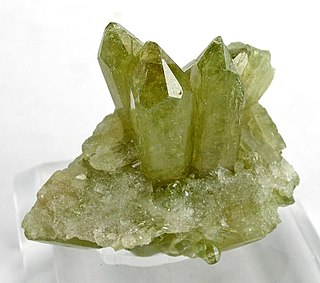
Vesuvianite, also known as idocrase, is a green, brown, yellow, or blue silicate mineral. Vesuvianite occurs as tetragonal crystals in skarn deposits and limestones that have been subjected to contact metamorphism. It was first discovered within included blocks or adjacent to lavas on Mount Vesuvius, hence its name. Attractive-looking crystals are sometimes cut as gemstones. Localities which have yielded fine crystallized specimens include Mount Vesuvius and the Ala Valley near Turin, Piedmont.
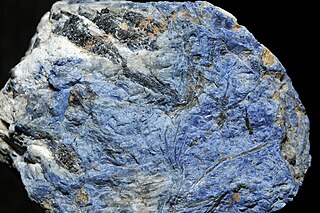
Dumortierite is a fibrous variably colored aluminium boro-silicate mineral, Al7BO3(SiO4)3O3. Dumortierite crystallizes in the orthorhombic system typically forming fibrous aggregates of slender prismatic crystals. The crystals are vitreous and vary in color from brown, blue, and green to more rare violet and pink. Substitution of iron and other tri-valent elements for aluminium result in the color variations. It has a Mohs hardness of 7 and a specific gravity of 3.3 to 3.4. Crystals show pleochroism from red to blue to violet. Dumortierite quartz is blue colored quartz containing abundant dumortierite inclusions.

Tusionite is a rare colorless to transparent to translucent yellow brown trigonal borate mineral with chemical formula: MnSn(BO3)2. The mineral is composed of 18.86% manganese, 40.76% tin, 7.42% boron, and 32.96% oxygen. It is a late stage hydrothermal mineral and occurs rarely in granite pegmatites in miarolitic cavities.

Stephanite is a silver antimony sulfosalt mineral with formula: Ag5SbS4. It is composed of 68.8% silver, and sometimes is of importance as an ore of this metal.

Annabergite is an arsenate mineral consisting of a hydrous nickel arsenate, Ni3(AsO4)2·8H2O, crystallizing in the monoclinic system and isomorphous with vivianite and erythrite. Crystals are minute and capillary and rarely met with, the mineral occurring usually as soft earthy masses and encrustations. A fine apple-green color is its characteristic feature. It was long known (since 1758) under the name nickel bloom; the name annabergite was proposed by H. J. Brooke and W H. Miller in 1852, from Annaberg in Saxony, one of the localities of the mineral. It occurs with ores of nickel, of which it is a product of alteration. A variety, from Creetown in Kirkcudbrightshire, in which a portion of the nickel is replaced by calcium, has been called dudgeonite, after P. Dudgeon, who found it.

Rammelsbergite is a nickel arsenide mineral with formula NiAs2. It forms metallic silvery to tin white to reddish orthorhombic prismatic crystals, and is usually massive in form. It has a Mohs hardness of 5.5 and a specific gravity of 7.1.
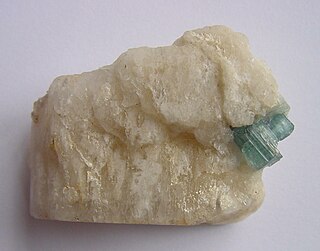
Beryllonite is a rare phosphate mineral with formula NaBePO4. The tabular to prismatic monoclinic crystals vary from colorless to white or pale yellowish, and are transparent with a vitreous luster. Twinning is common and occurs in several forms. It exhibits perfect cleavage in one direction. The hardness is 5.5 to 6 and the specific gravity is 2.8. Refractive indices are nα = 1.552, nβ = 1.558 and nγ = 1.561. A few crystals have been cut and faceted, but, as the refractive index is no higher than that of quartz, they do not make very brilliant gemstones.

Bismutite or bismuthite is a bismuth carbonate mineral with formula Bi2(CO3)O2 (bismuth subcarbonate). Bismutite occurs as an oxidation product of other bismuth minerals such as bismuthinite and native bismuth in hydrothermal veins and pegmatites. It crystallizes in the orthorhombic system and typically occurs as earthy to fibrous masses.

Tellurobismuthite, or tellurbismuth, is a telluride mineral: bismuth telluride (Bi2Te3). It crystallizes in the trigonal system. There are natural cleavage planes in the (0001) direction as the crystal is effectively lamellar (layered) in that plane. The Mohs hardness is 1.5 – 2 and the specific gravity is 7.815. It is a dull grey color, which exhibits a splendent luster on fresh cleavage planes.
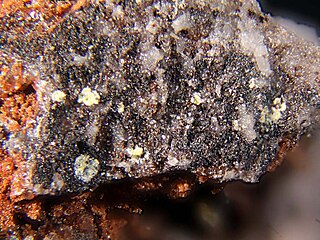
Russellite is a bismuth tungstate mineral with the chemical formula Bi2WO6. It crystallizes in the orthorhombic crystal system. Russellite is yellow or yellow-green in color, with a Mohs hardness of 3+1⁄2.

Zaïrite is a phosphate mineral with the chemical formula Bi(Fe3+,Al)3[(OH)6|(PO4)2]. The name was given from where it was locally discovered in Eta-Etu, Kivu, Congo (Zaïre) in 1975.

